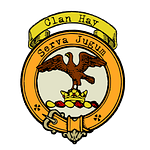Welcome back to "A Clan A Day Podcast," brought to you by bagtownclans.com. I’m your host, Colin MacDonald, and today, we’re diving into the storied history of Clan Baird. A family whose name carries tales of loyalty, innovation, and mysticism, the Bairds have left an indelible mark on Scotland’s history.
The origins of Clan Baird are rooted in both legend and historical record. The name is believed to have Norman origins, with chronicles from the time of the Norman Conquest mentioning a "Le Signeur de Barde," a follower of William the Conqueror. By 1178, the name appeared in Scotland when Henry de Barde, a marshal in Stirling, witnessed a charter by King William the Lion. The family firmly established itself in Lanarkshire during the 13th century, with Richard Baird holding lands at Meikle and Little Kyp. In 1329, Robert the Bruce granted the barony of Cambusnethan to Robert Baird, cementing the family’s place among Scotland’s landed elite.
The Baird family’s early prominence gave rise to tales and traditions that endure to this day. One famous legend tells of a Baird ancestor saving King William the Lion from a wild boar. In gratitude, the king supposedly rewarded the family with lands, a tale reflected in the boar passant on the Baird coat of arms. While historical evidence for this story remains elusive, it symbolizes the family’s enduring association with courage and loyalty.
Another cherished piece of Baird folklore is the prophecy of Thomas the Rhymer. According to the seer, “There shall be an eagle in the craig while there is a Baird in Auchmeddan.” This prophecy came to life when eagles nested near the Auchmeddan estate during the Bairds’ tenure, only to vanish when the estate changed hands. Strangely enough, the eagles returned briefly when the estate was inherited by a descendant of the Baird family, only to disappear again after it passed to the Gordons. Such stories contribute to the mystique surrounding the Bairds and their lands.
The Bairds produced remarkable individuals whose contributions spanned centuries. Among them was General Sir David Baird, a hero of the Napoleonic Wars. Sir David’s career was marked by extraordinary bravery, including the recapture of the Cape of Good Hope in 1807. Despite losing an arm at the Battle of Corunna, he assumed command of the British forces and continued to serve with distinction, earning numerous honors before his death in 1829.
In more recent history, John Logie Baird stands out as the most celebrated member of the clan. Born in Helensburgh in 1888, he revolutionized communication technology by pioneering the development of television. In 1926, he gave the world’s first demonstration of television, transforming modern media and cementing his place in history as one of Scotland’s greatest innovators.
The Bairds were also deeply connected to their lands and estates, which shaped much of their history. The family’s influence spread from their early holdings in Lanarkshire to Aberdeenshire, with Auchmeddan becoming a significant stronghold. George Baird of Auchmeddan strengthened the family’s ties to Scotland’s nobility by marrying into the powerful Keith family. Generations of Bairds served as hereditary sheriffs of Aberdeen, further enhancing their status.
In the 19th century, the Baird estate at Rickarton near Stonehaven became a lasting symbol of the family’s resilience. Today, it is the last working Baird estate in Scotland, managed by Richard Holman Baird and his family. With 6,000 acres of farmland, a horse-riding school, a husky sledging center, and various other activities, Rickarton is a vibrant hub of modern Baird life and a testament to the family’s enduring legacy.
Despite their storied history, Clan Baird currently lacks a recognized chief. The late Sir James Baird, 11th Baronet of Saughtonhall, sought recognition as the clan’s chief, a petition now expected to be continued by his son, Sir Alexander Baird. The absence of a chief has not diminished the clan’s spirit, however, thanks to the work of the Clan Baird Society Worldwide. Established in 1972, the society unites Baird descendants globally, preserving the family’s heritage and fostering a sense of community.
The Baird crest—a griffin’s head erased—and their motto, Dominus fecit, meaning "The Lord made," embody the strength and faith that have characterized the family for centuries. Their war cry, "Baird to the vanguard!", serves as a tribute to their long history of courage and leadership. The clan tartans, available in ancient, modern, hunting, and dress variations, provide a visual representation of their vibrant legacy.
From their origins in Norman France to their rise as a distinguished Scottish family, the Bairds’ journey is a story of resilience, innovation, and loyalty. Their influence spans the fields of battle, invention, and estate management, leaving a lasting imprint on Scotland and the world.
Thank you for joining us on this episode of "A Clan A Day Podcast." Tomorrow, we’ll explore the history of another remarkable Scottish clan. Until then, I’m Colin MacDonald, and as we say in Scotland, Go n-éirí an bóthar leat.











